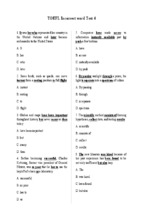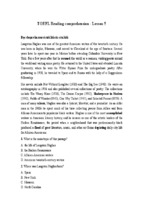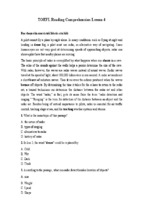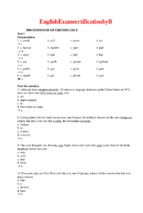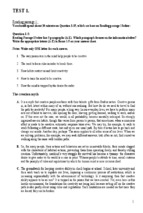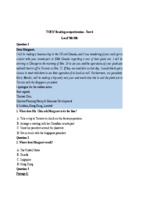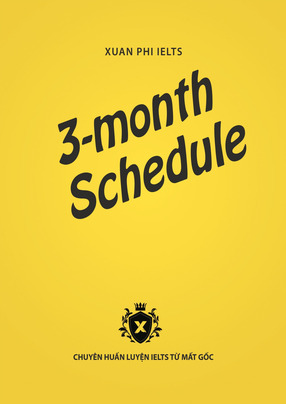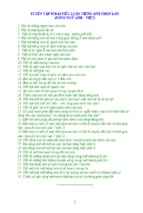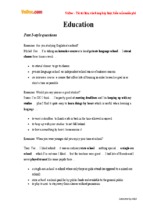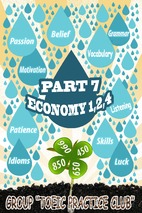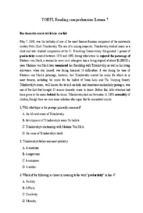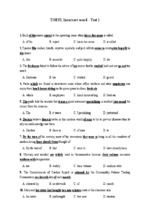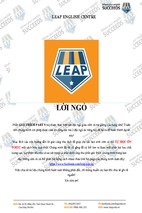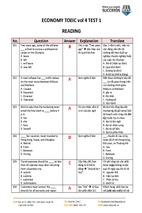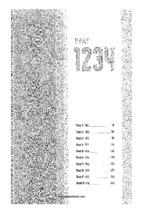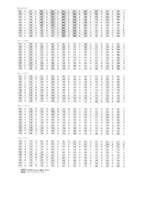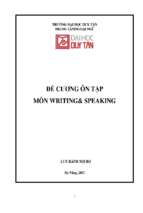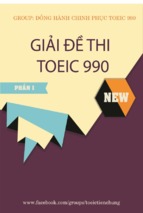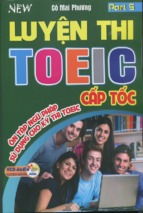IELTS
The Complete Guide to
General Reading
Plus 5 Complete Practice Tests
with answers
Phil Biggerton
All rights reserved
Copyright © 2014 by Phil Biggerton
No part of this book may be reproduced or transmitted in any form or by any means, electronic or
mechanical, including photocopying, recording or by any information storage and retrieval system, without
the written permission of the publisher, except where permitted by law.
For further information e-mail the author at:
[email protected] or visit: http://godivabooks.com/
ISBN: 978-0-9566332-2-4
Published by Godiva Books
Printed in the United Kingdom
The Author
Phil Biggerton has been teaching English in Asia since 1992. He became an IELTS examiner for
the British Council in Taiwan and has spent over fifteen years developing his skills as an IELTS
teacher. He established Godiva Books Publishing Company in 2010 and since then has published
both fiction and non-fiction books for other authors as well as his own IELTS textbooks. He
recently published the co-authored series Shortcut to IELTS with John Ross and Gary O’Connor.
CONTENTS
Page Numbers
Getting Started
The purpose of this book / Active - Passive reading
1-4
Unit One
Scanning and Skimming
5 - 12
Unit Two
Selecting the best keywords
13 - 20
Unit Three
Reading techniques / How to order your questions
21 - 28
Unit Four
Question Types 1 - 12
29 - 80
1. short answers
30 - 33
2. sentence completion
34 - 37
3. summary completion
38 - 41
4. multiple choice
42 - 46
5. table completion
47 - 51
6. labelling flow charts / processes
52 - 56
7. matching
57 - 62
8. paragraph selection
9. True, False, Not Given
63
64 - 68
10. Yes, No, Not Given
69 - 70
11. headings
71 - 78
12. diagrams
79 - 80
General Reading
Practice Test 1
82 - 94
General Reading
Practice Test 2
95 - 107
General Reading
Practice Test 3
108 - 118
General Reading
Practice Test 4
119 - 130
General Reading
Practice Test 5
131 - 142
Blank Answer Sheets
143 - 147
ANSWERS
149 - 152
Acknowledgments
153 - 157
Getting Started
Reading is an essential skill to learn if you want to say you are fluent in a language. Without this
ability you would miss out on the chance to obtain information from a wide range of different types
of material like, newspapers, magazines, journals, books, leaflets and brochures. Certainly, you would
never be allowed to enter a university to study if you were unable to read academic literature.
As a student entering either an undergraduate or postgraduate course, you are expected to have
reached a reasonably high level of ability in all four skills – reading, writing, listening and speaking.
How high these levels need to be varies from student to student (partly because of the subject they
have chosen to study) and from university to university. It might be possible, for example, to start a
postgraduate course at university with an overall IELTS grade of 5.0 on the condition that a
presessional course is taken first at the university.
However, due to the amount of reading required to complete your studies at university, it is far better
to aim for an IELTS grade of at least 6.0 in reading before you go to study. For some students this
grade or higher would be a basic requirement that has to be met before they are accepted at a
university to study their chosen course.
The IELTS exam
Your reading level can be measured by taking the IELTS exam. The reading section is made up of
three passages with each passage being approximately 700 to 1000 words in length. These texts are
not written specifically for the exam but are taken from a wide range of sources such as newspapers,
books, journals, and magazines, and can be academic or non-academic in style.
Although a wide range of topics are possible, no specialist knowledge is required. However, a fairly
extensive vocabulary range is needed if the text is to be completely understood. Topics can range
from subjects such as tea tree oil, herbal medicine, international airports, and beetles.
Some students find that some knowledge of the subject can encourage them to “guess” the answers
rather than use the text to get the correct answer. Many of these “guesses” can be wrong because the
student has not read the instructions or questions carefully enough.
The test itself consists of forty questions and a time of exactly sixty minutes to finish it. At the end of
the test your answers must be on the answer sheet provided. Note that, unlike the listening test, no
extra time is provided to complete the answer sheet, and so a grade of zero would be given if this is
blank after the allotted time.
1
The approximate IELTS Band Scores for the General Reading test are as follows:
Score out of 40
Grade
0
0
1
1
2
2
9
3
15
4
23
5
30
6
34
7
37
8
40
9
No two tests can ever be exactly the same, and so adjustments are made to each band score (after
pretesting) to standardize the test, and ensure that no one gets a harder test than someone else. It is
possible to have half grades in all four skills. So, for instance, nineteen out of forty for reading would
be grade 5.5.
Question Types
Questions come in a variety of forms (twelve different questions types will be discussed later in this
book) and test various skills such as scanning, skimming, reading for detail, recognizing the writer's
opinion, comparing and contrasting data from two sentences (a sentence from the text and a
question statement), selecting main ideas, inferring and so on.
The Purpose of this Book
The Complete Guide to General Reading takes you step by step, from a basic understanding of
the IELTS exam, to a point where you have the necessary skills and confidence to take the exam. It is
the intention of this book to provide you with everything you need to know to achieve a high grade
in reading. It has also been specifically designed to make your journey enjoyable and less frustrating.
Many of the sample exercises in Unit Four of this book are more difficult than you will face in the
real test. However, they will teach you the skills that you need to get a good grade in the actual test.
The five practice tests at the back of the book are very similar to the actual General IELTS exam.
2
How much studying do I need to do?
Many students like to ask the question, “When can I get a grade 6.0?” or similar questions. It really is
impossible for your teacher to say unless he knows you very well. Even then the answer given would
be more like a guesstimate. People learn at different speeds, and the amount of homework they are
prepared to do also varies from person to person. However, an approximate guide suggested by
Cambridge ESOL is shown below. Someone requiring an overall grade of 6.0, for example, should
expect to study (with a teacher) for between 500 and 600 hours if starting with no knowledge of
English. Somebody hoping to improve from a grade 5.0 to grade 6.0 would need about 100 hours of
studying.
Hours of Studying
IELTS grade
1000 – 1200 hours
7.5+
700 – 800 hours
6.5 – 7.0
500 – 600 hours
5.0 – 5.5 – 6.0
350 – 400 hours
3.5 – 4.0 – 4.5
180 – 200 hours
3.0
90 – 100 hours
1.0 – 2.0
Source: CEF and Cambridge ESOL recommended guidelines
How should I read?
This might seem a rather obvious question, but it is, nevertheless, worth asking before you start to
work through this book: “How should I read?” If you think carefully about this you will probably
come to the conclusion that it depends on what you are reading and why you are reading it.
Although there are many different types of reading material, it is possible to divide them into two
main groups:
1. The things you read for pleasure, like novels
2. The things you read when studying (or fact finding)
When you read for pleasure you will tend to focus more on being entertained and will enjoy the
actual style of writing used, but when you read to study you do so to collect facts and figures.
With both types of reading you can be either a passive reader or an active one. Which one do you
think is a better way of reading?
3
Two Styles of Reading
The answer for both types of reading is active. This can be more easily understood if we look at the
two types of reader.
The Passive Reader
The main problem with a passive reader is that they want the writer to do all of the work. They want
the writer to do the thinking, the analyzing, the development of ideas, to state what is important and
what isn't, what the implications of reading this are, how to use the information in the future and so
on. The result is that the passive reader often reads slowly, has trouble concentrating, and has no real
understanding of the structure of the thing they are reading.
The Active Reader
The active reader, on the other hand, develops an ongoing relationship with the writer. Information
is read critically and any observations made are related to information previously read, or experience
and knowledge obtained. An understanding of the structure of the text (even a form or newspaper) is
essential if a more active approach to reading is used. Scanning, skimming and reading for further
detail are all active reading skills and would not normally be used when reading for leisure.
Remember, it is your choice. Do you want to be an active or a passive reader? If you are already an
active reader then well done. Do not change your style of reading as this is the correct way to read
when at university. This style is also essential when studying for, and when taking, the IELTS test. If
you are a passive reader you MUST change and this book will help you to do that.
4
UNIT ONE
Stop Reading!!!
One of the key skills to learn as you work through this book, is how to look at a text but not read it.
This might sound rather strange advice, “Don't read the reading passage.” To understand this, look at
the text about a shipwreck and answer the question below to see why this is a useful approach to
improving your reading.
Question:
The Wreck
The decade began with serious plans to explore the German Battleship Ostfriesland, a wreck
lying a long way offshore in 380ft of water. During a milestone wreck diving operation Gentile,
Pete Manchee and Ken Clayton made a single Heliox dive each to the wreck using custom
decompression tables designed by Dr Bill Hamilton. The way now had been set; Gentile had
shown that these previously inaccessible sites were now slowly becoming a possibility. In 1991
the late Captain Bill Nagle and John Chatterton led a team of experienced amateur shipwreck
divers on an expedition to explore an unknown wreck at a site approximately 60 miles east of
Point Pleasant, New Jersey. Upon descending to the wreck, the divers discovered what
appeared to be the remains of a submarine in approximately 77 meters of water. The general
appearance was that of a World War II era submarine wreck. On subsequent dives it was
discovered that there were human remains aboard the wreck, but the identity of the
mysterious "U-Who" would not be confirmed as that of U-869 until nearly six years later.
1. Did you read the whole text?
2. How long did it take to answer the question?
If you did read the whole text (and it is much smaller than texts in the real test) you would have taken
longer to get the answer (sixty miles) than if you had used one very important reading skill that you
need to learn – scanning.
Remember: looking is a lot quicker than reading.
5
What is scanning?
Scanning can be seen as the ability to look for individual words or short phrases of two to three
words. This is done by looking for a few words rather than reading the whole text. A student who is
a skilful scanner will be able to answer certain questions in the test without developing an
understanding of the structure or even content of the passage. Developing this skill will save you
time.
The ability to get the answer quickly from the short text about “The Wreck”, was not based on
understanding the whole text. Rather, it was based on reading the question carefully and realizing that
the answer can be easily found by picking the words, Captain Bill Nagle (these are known as
keywords) and then looking for them. Scanning the text for capital letters – C, B, N – allows you to
focus on looking for (not reading) a name. Knowing that the answer is probably a number also lets
you focus on looking for this as well.
Other keywords could have been picked – shore and explore – but the word, wreck, would have
been a bad choice because it is the title (and topic) of the text. The word, wreck, appears seven
times, and shipwreck once, in this paragraph. Can you think of other types of information that can
be found by scanning?
In fact, any word can be found by scanning, but the easiest words to find are those with:
1.
Capital letters: names of people, places, cities, countries, companies.
2.
Numbers such as 1996, 21st January, 800kg, and 5 million. Remember that numbers can also be
written as words like the twentieth century, eighteen fifty five, three people and so on.
Depending on the type of word you are looking for, it might be useful to have a better idea of the
structure of the text. In other words, where is the answer more likely to be, at the beginning, the
middle or end of the passage? This can be done by skimming.
What is skimming?
Skimming allows you to get the gist (or general understanding) of the structure of the text and what
information it contains. When faced with many books to read at university (or in the case of the
IELTS exam, three long reading passages), this skill is invaluable. Why read something if it is not
going to give you the answer you need? Why read a sentence, a paragraph or much worse a whole
text, if it is not going to lead to an answer? Do not waste time by reading what is not important.
One result of the computer age, however, has been a slowing down of skimming skills on the
computer when compared with skimming on paper. Research in 1991 by Paul Muter and Paula
Maurutto from the Psychology Department at the University of Toronto suggests that skimming
skills should be practiced using books, rather than a computer monitor, but that comprehension and
the actual speed of reading are the same for books and computers.
6
The way we usually read
In English, as indeed in many but not all languages, you learn to read from left to right and from the
top of the page to the bottom. From a very early age you have probably been conditioned to look for
information in this way. So, when you are trying to look for information, many students will try to
read all of the text – from left to right and top to bottom. One problem with this is that many
students read very slowly and so find answers very slowly. Remember that you only have 60 minutes
for the whole test. This works out, on average, at one and a half minutes per question.
As a quick little test, read all of the passage on page 8 about Colditz and time how long it takes. Read
at your normal speed. If it takes you, let's say, ten minutes then you will need at least thirty minutes to
read three passages. This leaves only thirty minutes to read forty questions, find forty answers and
write these answers in the answer sheet. This is not enough time for most students.
Scanning Practice
To help solve this time wasting style of finding information, and to improve your scanning skills, it is
important to learn to look at the text from left to right, as well as from right to left, as you work
down the page. Doing this helps stop you from reading the text as most people don't read
backwards! You might also be able to start scanning in a different part of the text if you have begun
to get a better idea where information is.
Look at the text on page 8 again and look for the words in List One below. Take one word at a time
and try to find it very quickly. DO NOT mark where you find the words in the text.
List One
600
Dutch
Bill
1945
Colditz Castle
Straflager
Goering
November 6th
Jack Best
31
Poles
River Mulde
Polish
RAF
60
Germany
Now use the same text and try to find all of the words from List Two. Again look for one word at a
time and DO NOT mark where you find the words in the text.
List Two
tailoring
chapel
sport
troops
bed
two
millet
material
cliff
national
tunnels
six
one
wood
forgery
security
NOTE - some words can be found more than once in the text.
7
Colditz achieved fame after World War Two as the prisoner of war camp that no one could
escape from. Colditz was an isolated castle built on top of a cliff, overlooking the River Mulde in
central Germany. To all intents it was seemingly impossible to escape from - so the Germans
believed. However, this did not mean that men did not try to do so and by putting together the
best escapees from POW camps, the Germans effectively made a problem for themselves.
In the early days and months of the war, Colditz was used as a transit camp for Polish troops after
the surrender of Poland. On November 6th, 1940, a handful of British RAF officers arrived,
quickly followed by six British Army officers. By the end of the year, the numbers had increased
and included French, Dutch and Belgium POW's. Colditz was seen by the Germans as a ‘supercamp’ where men who could not be held by other POW camps were sent. Officially, Colditz was
a Sonderlager (Special Camp) but it was also known as a Straflager (Punishment Camp).
Men of all nationalities were brought to Colditz from 1941 onwards. It housed 600 POW’s –
British, French, Belgium, Dutch and Poles. Each nationality tended to stick to themselves and
there was little national intermingling. The French and British did set up language lessons
between themselves and some sport was played within the confines of the castle. However, the
one thing that united all of them was that they were at Colditz for a good reason, and it was this
defiance of German authority, despite being prisoners, that did unite all the POW’s at the camp.
The Germans had put together in one camp many experts in forgery, lock picking, tailoring and
so on - all vital for the success of escaping. With such a collection of experts, it was only a matter
of time before escape attempts were made.
Hermann Goering had visited the castle and declared it to be escape proof. He was proved to be
wrong. In the time Colditz was used as a POW camp, there were many escape attempts. One
hundred and twenty of these men were recaptured after breaking out, but by the end of the war,
31 POW's had successfully got back home. No other POW camp in World War Two had the same
rate of success.
There was little to do at Colditz and time was spent trying to escape. Probably the most famous
attempt at escape was the building of a glider in an attic above the castle chapel. When the glider
was built, the idea was that the glider could be catapulted from the roof to the other side of the
River Mulde with two men on board. The idea came from Bill Goldfinch and Anthony Rolt.
Together with Jack Best and Stooge Wardle, they set about designing and building the glider.
Using hundreds of pieces of wood - especially bed slats and floor boards - the men constructed
the glider which they hoped would glide the 60 metres required to take two men to the other side
of the Mulde. The skin of the glider was made from prison sleeping bags and the material's pores
were sealed by boiling prison issue millet and smearing it onto the material. However, their
daring idea was never put to the test as the war ended before the glider had been completed.
Tunnels were also built but the thickness of the castle walls made digging tunnels very slow
work. Also by 1944, the Germans had worked out many of the ways that POW's had been using
to escape and these lapses in security had been plugged. Colditz Castle was liberated on April
16th, 1945.
8
Scanning Practice Review
You probably found that words from List One were generally easier to find than words from List
Two. Therefore, it is usually better to pick keywords like those in List One when trying to find
answers from a reading passage.
You might find, however, that your scanning skills are a little weak and more practice is needed even
to find the List One type keywords. To help with this, look at the nutrition fact sheet below and
answer the following questions.
Nutrition Facts
Serving Size 2 tortillas (51g)
Servings Per Container 6
Amount Per Serving
Calories 110
Calories from Fat 10
Nutrition Facts
Question 1.
What type of food is this information about?
Question 2.
What percentage of your daily iron do you get per
serving?
Question 3.
% Daily Value* How many calories per gram of fat would you get?
Total Fat 1g
Saturated Fat 0g
Trans Fat 0g
Cholesterol 0mg
Sodium 30mg
Total Carbohydrates 22g
Dietary Fiber 2g
2%
0%
0%
0%
1%
7%
9%
Question 4.
How much sodium should you have per day on a 2000
calorie diet?
Question 5.
How many calories would you get with two servings?
Index
Vitamin A 0%
Calcium 2%
Vitamin C 0%
Iron 4%
*Percent Daily Values are based on a 2,000
calorie diet. Your daily values may be higher or
lower depending on your calorie needs
Calories
Total Fat
Less than
Saturated Fat Less than
Cholesterol
Less than
Sodium
Less than
Total Carbohydrate
Dietary Fiber
2,000
2,500
65g
80g
20g
25g
300mg 300mg
2,400mg 2,400mg
300g
375g
25g
30g
Calories per gram
Fat 9
-
Carbohydrate 4
-
Protein 4
Now look at the index on page 10 and write down the
page number (or numbers) where information on each
topic can be found.
Topics
1.
2.
3.
4.
5.
6.
7.
8.
9.
Rust
Hair that is short and smooth
How to find visual keys
Applying logic
Fabriano paper
Basic indenting techniques
Reflected light
Shadows on water
Key highlights
9
Index
Drawing ………………………….….. 228, 270
Used in …………….. 61, 185, 188, 190, 264
N
Fine hair ……………………………….….….. 235
Lead holders ……………………………………… 14
Negative drawing
Human hair …………………………..… 82,84
Light absorbency …………………………. 208
Basics ………………………….……… 107, 193, 213
Long Straight hair ……………..……… 233
Light and Shade
Benefits of method ………………………..… 107
Ringlets ………………………………………… 240
Cast shadows ……………………………....... 123
Cat ……………………………….…….. 163, 165, 167
Smooth short hair …………………….. 236
Catch light ……………………………….……… 124
Grass ………………………….……………….... 110, 211
Very short hair ………………………….. 237
Contact shadows ………………….……….. 123
Hair ……………….... 84, 230, 231, 257, 270
Wavy hair …………………………………….. 241
Core shadows …………………….………..... 124
Latch …………………………………………….……… 192
White, drawing ………… 229, 232, 271
Hard light ……………………………………….. 128
Pre-planned ………………………….….. 109, 271
Wire hair ……………………………. 239, 270
Highlight ………………………………..….….... 123
Problems, skirting ……………………….….. 109
Highlight ……………………………………….. 123
Key highlight …………………….………….... 124
Rope ……………………………………………..……. 275
I
Light source ……………………..…………….. 122
Rust ……………………………………………….….... 191
Indenting
Reflected light ………………………………… 125
Spontaneous …………… 109, 112, 270, 272
Basic technique ……………………………. 67
Secondary highlight ……………..…….... 124
Status stalks ……………………………………….. 111
Coated-card techniques …………….. 75
Shadows …………………………….…………….. 123
Negative space
Direct method ……... 69, 71, 235, 241
Shadows on water ……….…………….... 207
Demonstrated ……………………….... 92, 220
Dot method …………………………………... 73
Soft light ……………………………………..…… 129
Mask, using …………………………….……….... 94
Graphite method
Source distance ………………..………….... 129
Using …………………………………………….….... 146
……………………….. 74, 75, 238, 249, 257
Twin light sources …………………….….. 129
O
Indirect method ……………………. 72, 73
Light box ……………………………….………… 146
Opaque projector …………………………..... 148
Not used in hair ………………………… 270
Lignin content ……………………..……….... 29
Overhead projector ……..……………….... 147
Stylus ………………………………………………. 25
Line drawing, techniques ……………… 32
P
Used in …………………………………. 163, 271
Line
Papers
K
Edges ………………………………………..……….. 36
Canson …………………………………….….…….... 28
Key highlight ……………………… 124, 206
Weight ……………………………..……………….. 35
Fabriano …………………………………….………… 29
Keys, visual
Width ……………………………………….………… 34
Illustration board ………………...…………… 29
Basics ……………………………………….. 91, 133
Local shading ………………………………… 229
Ivorex …………………………………………...……… 28
Extracting ……………. 101, 133, 182, 275
Logic, applying ………………………… 95, 116
Mellotex …………………………….……………..... 28
Finding ………………………………………….. 132
M
Plate finish …………………………………………. 28
Using …………………………………….. 133, 185
Managing work
Strathmore ………………………….…………….. 28
Kneadable eraser ………………………….. 18
…………………………………….... 94, 109, 111, 232
Types ……………………………………………...…… 27
L
Margin, cleaning …………………………… 277
Vellum finish ……………………………….….... 28
Layering
Matting work …………………...………….... 136
Pencils
Basics ………………………………………. 56, 59
Mechanical pencils ……………………….... 15
Clutch pencil …………………………………….... 14
Shaping form
Metal, rusty …………………………………….. 191
Grades. choosing ……………………..……….. 36
………………………………... 87, 164, 214, 230
Motivation of drawing ………………..… 99
Grades, illustrated …………………….………. 35
Shaping form …….. 87, 164, 214, 230
Mouth, human ……………………………….. 79
Mechanical pencil ………………………………. 15
10
Scan - Scan - Scan: Practice as much as you can
It is possible to further develop your scanning skills. If you have a friend who is also studying IELTS,
or simply wants to improve this skill, you can take it in turns to ask each other to find certain words
from a text that you both have. For instance, you can both buy a local paper, or photocopy a text
from a magazine. Start with the more obvious words with capital letters, or numbers, and then move
onto other words. Try not to pick words which are in the text too many times.
Again, DO NOT mark where you find the words in the text. The reason for this is because, as soon
as you start to put marks on the text, you are beginning to give the reading passage structure. This
then starts to make it easier and easier to find other words, because you are beginning to build up a
reference of what type of information is in which paragraph. So, for the purposes of practicing this
particular skill, it is better not to mark the paper. It makes you focus more on the text and not rely on
what you have already found.
Both scanning and skimming require faster eye movement and the ability to process information
quickly. If you find yourself moving your lips as you look for information then you are probably
reading. Stop it! Also, during the times when it is essential to read in more detail, stop yourself from
reading quietly to yourself. You can read more quickly mentally than you can physically say the
words. Stop those lips from moving!
Skimming Practice
There are a number of different ways to skim successfully. You can develop a better understanding
of structure in a text by reading the title and subtitle at the beginning of the text, sub headings (if
there are any) for each paragraph or section of the text, and by looking at any illustrations or
diagrams. Reading the first sentence in each paragraph can also result in a better understanding of
content and structure but does take longer, possibly too long if you read quite slowly. However, all of
these skills will improve with practice.
Time spent skimming books, newspapers, forms, magazines, and journals, in fact time spent
skimming as many different things as you can, develops this skill.
Good writing happens because the writer understands how a reader organises information in his/her
mind. In turn a good reader comes from understanding how people write. The two skills are very
intimately connected and so by improving your reading skills you will be improving your writing skills
and vice versa.
11
Combining Scanning and Skimming Skills
Look at the paragraph below and do three things,
1.
Scan the text and underline all proper nouns (those with capital letters) and numbers.
2.
Read the first and last sentence of the paragraph. NOW - CLOSE YOUR BOOK.
3.
Write one or two sentences explaining what the paragraph is about.
The Tea Trade
When America eventually won its
independence from British rule in 1783, it
began its own free and independent tea
trade with China. The success of this
trade made some people in Britain
question the wisdom of the East India
Company's ongoing monopoly on British
trade with the East. In 1813, the
Company lost its monopoly on trade
with India, but still had a complete
monopoly on trade with China, which
meant it was heavily dependent on the
tea trade. The Company's charter was
due for renewal in 1834, and in the
decades before that there was a growing
call for the abolition of the monopoly
and the instigation of free trade with
China as well. Supporters of free trade
argued strongly that the Company kept
tea prices artificially high in order to
maximise its profits, using tactics which
included restricting the supply of tea.
One anonymous pamphleteer, writing in
1824, stated that ‘the lordly grocers of
Leadenhall Street [where the Company
was based] have most scandalously
abused the monopoly of which they are
now in possession.’ Comparing the
prices of tea sold at auction in London
with the prices at auction in Hamburg
and New York, he thundered that ‘the
monopoly of the tea trade enjoyed by the
East India Company costs the people of
this country, on average, not less than
two million, two hundred thousand
pounds sterling a year!’
Even if you do not know exactly what the paragraph is about, spending a little time on scanning and
skimming will have given you some useful information. Also, by underlining certain words and
numbers you have also added structure to the text.
Remember that the more you know about the structure of each passage you read, the more chance
there is that you will know where to look for answers. This will save you a lot of valuable time, time
that you can spend more effectively on detailed reading of the sentences where you know answers are
likely to be.
A possible summary on the tea trade text could be:
This paragraph is about the tea trade in the late 18th and early 19th century and the rivalry between
America and Britain. The East India Company created a tea monopoly which resulted in very high
prices in London.
12
UNIT TWO
Keywords
As we saw in Unit One, the ability to find individual words or short phrases through scanning is an
important skill to develop. This will enable you to find answers to questions much more quickly
because of this, particularly when using proper nouns (capital letters) and numbers. Not all
paragraphs (or texts) have as many proper nouns or numbers as the examples shown in Unit One but
this is one reason why some reading passages might be harder than others.
Any word that you choose from a question sentence to help you find the answer can be called a
keyword. The selection of good keywords is an essential part of finding answers to questions more
quickly and more accurately. This unit, therefore, will explore in a little more detail how to select
good keywords.
Instructions: Look at the questions below that go with the text on pages 14 and 15 and underline
what you think is the best keyword for each question. Then write down what type of answer you
expect to find.
DO NOT turn the page. Only look at the question sentences on this page when you are selecting the
keywords
Questions 1 - 8
Answer the questions below.
Choose NO MORE THAN THREE WORDS AND/OR A NUMBER from the passage for each answer.
Question
What answer do you expect?
1
How old is the Armenian shoe?
___________________
2
What was found in the shoe?
___________________
3
What environmental factors protected the shoe?
___________________
4
What was the shoe covered with?
___________________
5
How old was the shoe originally thought to be?
___________________
6
What two things were tested to determine the age of the shoe?
___________________
7
Who found the shoe?
___________________
8
When did Irish people wear similar shoes?
___________________
Now find the answers from the reading passage on pages 14 and 15. There are eight questions and so
it should (on average) take twelve minutes to complete. Don't forget to quickly scan the text first for
proper nouns and numbers and underline what you find.
13
World's oldest leather shoe found in Armenia
A perfectly preserved shoe, 1,000 years older than the Great Pyramid of Giza in Egypt and 400
years older than Stonehenge in the UK, has been found in a cave in Armenia. The 5,500 year old
shoe, the oldest leather shoe in the world, was discovered by a team of international
archaeologists.
The cow-hide shoe dates back to 3,500 BC (the Chalcolithic period) and is in perfect condition. It
was made of a single piece of leather and was shaped to fit the wearer’s foot. It contained grass;
although the archaeologists were uncertain as to whether this was to keep the foot warm or to
maintain the shape of the shoe, a precursor to the modern shoe-tree perhaps? “It is not known
whether the shoe belonged to a man or woman,” said lead author of the research, Dr Ron Pinhasi,
University College Cork, Ireland “as, while small, (European size 37; US size 7 women), the shoe
could well have fitted a man from that era.” The cave is situated in the Vayotz Dzor province of
Armenia, on the Armenian, Iranian, Nakhichevanian and Turkish borders, and was known to
regional archaeologists due to its visibility from the highway below.
The stable, cool and dry conditions in the cave resulted in exceptional preservation of the various
objects that were found, which included large containers, many of which held well-preserved
wheat and barley, apricots and other edible plants. The preservation was also helped by the fact
that the floor of the cave was covered by a thick layer of sheep dung which acted as a solid seal
over the objects, preserving them beautifully over the millennia!
“We thought initially that the shoe and other objects were about 600-700 years old because they
were in such good condition,” said Dr Pinhasi. “It was only when the material was dated by the
two radiocarbon laboratories in Oxford, UK, and in California, US that we realised that the shoe
was older by a few hundred years than the shoes worn by Ötzi, the Iceman.”
Three samples were taken in order to determine the absolute age of the shoe and all three tests
produced the same results. The archaeologists cut two small strips of leather off the shoe and sent
one strip to the Oxford Radiocarbon Accelerator Unit at the University of Oxford and another to
the University of California – Irvine Accelerator Mass Spectrometry Facility. A piece of grass
from the shoe was also sent to Oxford to be dated and both shoe and grass were shown to be the
same age.
The shoe was discovered by Armenian PhD student, Ms Diana Zardaryan, of the Institute of
Archaeology, Armenia, in a pit that also included a broken pot and wild goat horns. “I was
amazed to find that even the shoe-laces were preserved,” she recalled. “We couldn’t believe the
discovery,” said Dr Gregory Areshian, Cotsen Institute of Archaeology at UCLA, US, co-director
14
who was at the site with Mr. Boris Gasparyan, co-director, Institute of Archaeology, Armenia
when the shoe was found. “The crusts had sealed the artefacts and archaeological deposits and
artefacts remained fresh dried, just like they were put in a can,” he said.
The oldest known footwear in the world, to the present time, are sandals made of plant material,
that were found in a cave in the Arnold Research Cave in Missouri in the US. Other
contemporaneous sandals were found in the Cave of the Warrior, Judean Desert, Israel, but these
were not directly dated, so that their age is based on various other associated artefacts found in
the cave.
Interestingly, the shoe is very similar to the ‘pampooties’ worn on the Aran Islands (in the West
of Ireland) up to the 1950s. “In fact, enormous similarities exist between the manufacturing
technique and style of this shoe and those found across Europe at later periods, suggesting that
this type of shoe was worn for thousands of years across a large and environmentally diverse
region,” said Dr Pinhasi.
“We do not know yet what the shoe or other objects were doing in the cave or what the purpose
of the cave was,” said Dr Pinhasi. “We know that there are children’s graves at the back of the
cave but so little is known about this period that we cannot say with any certainty why all these
different objects were found together.” The team will continue to excavate the many chambers of
the cave.
15

